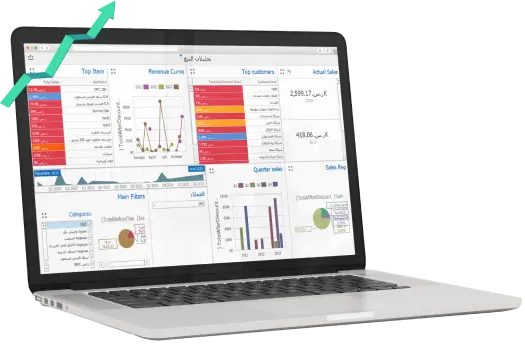With the increasing numbers of companies, the role of financial accounting in providing financial and accounting information is no longer sufficient to manage the functions of control, planning and decision-making, there is no accurate information of the cost of the product, nor of the variable costs required to produce one unit of the product, as well as the fixed costs incurred by the company for production, etc. information necessary for management to planning product management or decision-making of productivity, the main objective of any production activity is profit, and that is by profits maximization and reducing costs to the lowest possible extent, how can this be achieved without basic information of product costs and hence the urgent need for cost accounting emerged, all the above questions can only be answered with the use of cost accounting, which has a significant role in providing all information of the product costs in a way that helps the management in planning, control and decision-making regarding the production of a particular product or not, as well as determining the prices of products and controlling production costs, which made cost accounting a great role in companies from their inception until now, so the activity is not without use cost accounting, whether it is an activity (industrial- agricultural- commercial- service- production ....) with the emergence of modern technology and the increasing numbers of companies and branches, cost accounting has evolved and modern systems have emerged in cost accounting, which we will review as follows:
Cost Accounting Definition
Cost accounting is defined as one of the branches of accounting that aims to record and classifying cost data to provide all the information that the management needs in planning, control, and decision making functions, the cost accounting mechanism is represented in (inputs- processes- outputs) so the inputs are in the prime cost data that is collected from the cost center of the activity and these prime data are treated, analyzed and classified through the tools and procedures for cost accounting the so-called processes stage and then provided cost accounting the financial information and reports necessary for functions of management to planning, control, and decision making the so-called outputs.
|
Inputs |
Processes |
outputs |
To learn more about cost accounting business practice tools and procedures, we need to learn about the division of costs to various categories, to learn more about the nature of cost and analyze it to proper classifying this cost in the financial statements, the following will cover the most important types of costs.
Types of Costs
The types of costs are too many and they are classified to the purposes of cost control in addition to the proper treatment of the cost in the financial statements (outputs), we will cover the most important cost classifications as follows:
1- Costs can be classified according to their behavior in relation to changes in the level of activity or volume of production
The costs can be classified as:
A- Variable Costs
Variable costs are costs that vary in proportion to the production volume, they rise as production volume increases and fall as production volume decreases, i.e. there is a direct relationship between the variable costs and the production volume, for example, to produce a room in a furniture factory, we need 1 cubic meter of wood as well as 1 kilogram of nails while it's to produce 100 rooms, we need 100 cubic meters of wood as well as 100 kilograms of nails and so on.
B- Fixed Costs
Fixed costs are costs that do not change with an increase or decrease in the production volume but remain unchanged (at a certain production volume), for example, the rent expense, utilities expense, etc., but these costs are indirectly and negatively associated with the production volume, the larger the production volume, the lower one unit proportion of the product of these costs, for example, if the factory rent is 5,000 pounds, then if we produced 100 units of the product, the one unit proportion of the factory rent would be 50 pounds while the production of 1000 units of the product will make its proportion of the factory rent only 5 pounds.
2- Costs can be classified according to the nature or elements of cost
The costs can be classified as:
A- Direct Costs
Direct costs are costs that can be directly linked to the unit of the product, such as direct materials and direct labor, for example, to produce a loaf of bread, we need direct materials in making the loaf, which is flour, water, baker's yeast, etc., as well as direct labor related to bread production, such as wages for the baker, bakery workers, and others.
B- Indirect Costs
Indirect Costs are costs that cannot be linked directly to the unit of the product but are accumulated and then allocated to the units of the product which are
1- Indirect Material Cost
Such as oils and greases needed by machinery and equipment in factories.
2- Indirect Labor Cost
Such as wages for administrative supervisors.
3- Indirect Overhead Costs
Such as marketing and selling costs, asset depreciation, and others.
3- Costs can be classified based on functions or activities in an organization
The costs can be classified as:
A- Production Costs
Production costs are all costs related to the stages of the production process, such as materials costs, labor costs, and services for the production of the product, whether direct or indirect.
B- Marketing and Selling Costs
Marketing and selling costs are all costs related to selling the product and the product marketing, such as advertising, promotion expenses, sales incentive costs and marketing, and others.
C- General and Administrative Expenses
General and administrative expenses are all expenses incurred by the company for the management, supervision, and control functions such as administrative staff wages and general expenses such as rent of the administrative headquarters and utilities expense such as electricity, water, and telephone, fixed assets depreciation, and others.
4- Costs can be classified based on time/period
The costs can be classified as:
A- Actual Costs
Actual costs are the costs that the company has already incurred in a previous period.
B- Standard Costs
Standard costs are the costs that the company plans to incur (implement them) in the next period.
After we have covered the most important cost classifications, we will cover the most important cost accounting systems
Cost Accounting Systems
Cost accounting systems are defined as a set of procedures followed for treating and classifying costs that differ according to the nature of each activity and perhaps the most important costing systems
A- Job Order Costing System
This system is based on measuring the costs incurred by each job order separately, and this system (job orders) is compatible with some activities and not others, such as the contracting activity, in which all the costs associated with the job order are accumulated based on the orders and characteristics requested by the customer related to each job order such as accumulating of all costs for the creating of (a housing unit) as well as it is suitable for restaurants so that the costs are calculated for each meal may differ from other meals.
B- Process Costing System
This system is based on measuring costs in activities that a characterized by mass production of (similar or identical units) like factories, in the factory always produces similar units that need the same cost elements of direct materials cost and direct labor cost and manufacturing overhead cost and need the same stages of production starting from being raw materials to convert them into a finished product.
There are several cost accounting methods, perhaps the most important of them
Cost Accounting Methods
The theories and methods of calculating costs varied and evolved and can be mentioned as follows:
A- Full Costing
This method depends on calculating all the costs incurred by the company, whether direct or indirect, fixed or variable and allocating these costs to the production volume to determine the proportion of the single unit of costs and this theory is fully proportional to the principles and concepts of financial accounting and is considered one of the oldest cost theories and is criticized for by its omission of determining the cost incurred by each unit separately, which weakens the control functions and identifying the shortcomings of the costs of a particular cost center without others.
B- Partial Costing
This method is based on the separation between cost elements, as it separates fixed costs from variable costs and direct costs from indirect costs, and this method includes three ways to calculate the cost and they are
1- Variable Costing
This method based on separating between fixed costs and variable costs and allocating of the product by variable costs only, whether direct or indirect, as for the fixed costs, they are allocated into the income statement, this method is characterized by assisting the management in controlling the variable costs and working to reduce them, but it is a disadvantage for them to omit controlling fixed costs.
2- Direct Costing
This method is based on the separation between direct costs and indirect costs and allocating of the product by direct costs, while indirect costs appear only in the income statement and this method is distinct in activities where the ratio of direct costs to total costs is charged with neglecting indirect costs, thus reducing the functions of controlling indirect costs and therefore difficult to use this method in companies.
3- Normal Overhead Absorption Costing
This method is considered a compromise about the full and partial method it allocates the product by variable costs in addition to its proportion of fixed costs within the utilized capacity for the product (the proportion of the product fixed costs) while the fixed costs of unutilized capacity such as general expenses, administrative, sales and others are allocated to the profit and loss (P&L) statement and this method is characterized by has provided a solution to the previous methods as it did not omit the fixed costs exactly as in previous methods but it is burdened with its failure to allocate the product with its proportion accurately of selling and marketing costs as well as inaccuracies in calculating the costs of the stored goods.
C- Standard Costing
This method is based on the creation of budgeting, in which a standard cost is determined (a cost that is predetermined on bases) and a comparison of these standard costs with the actual costs that the company has already incurred to reach variances and then tighten the process of controlling the cost and address the shortcomings, and these variances can be divided at the level of each production element
1- Material Cost Variance
It is divided into a quantity variance and in which the quantity that is purchased exceeds the standard quantity planned to be purchased in the budgeting and this case it is called negative variance (undesirable) but if the quantity purchased is reduced from the planned quantity is called a positive variance (desirable) as well as a price variance means that the materials were purchased at a price (greater/ lower) than the standard price planned.
2- Labor Cost Variance
It is divided into a rate variance in which (increases/decreases) the actual cost of labor from the standard cost of labor in the budgeting as well as labor efficiency variance of labor hours (more/less) to accomplish the activity due to the inefficiency of the labor in terms of (increases/decreases) production costs.
3- Overhead Cost Variance
It is divided into spending variance and in which (increases/decreases) actual expense over planned expense as well as overhead efficiency variance (increases/decreases) the actual hours worked (period) of indirect costs over the planned hours costs.
These were the most important traditional methods of cost accounting, but with technological advances and product diversification, these traditional methods are no longer suitable for calculating costs in companies, therefore, the trend towards modern methods of cost accounting has emerged, the most important of which is an ABC system,
Activity-Based Costing (ABC)
The need for an activity-based costing (ABC) system emerged to address the shortcomings provided by traditional methods of calculating costs, traditional methods always provide shortcomings especially in calculating fixed and indirect costs so that the product does not allocate its proportion of the costs accurately, but the activity-based costing (ABC) emerged to allocate the costs to activities as cost centers, and then the products are allocated to the consumption of activities, and therefore providing a solution to the problem of indirect and fixed costs and made the cost of the products as accurate as possible, and this method is characterized by helping the department to exclude useless activities that non-value-added to the product and focus on and enhance the important production activities.
Cost Reduction Techniques
Business costs can be reduced through several methods, which are:
1- Target Costing (TC) Method:
It is based on determining the cost in advance of the production process by setting the prices of the products and adding a specific profit margin and then product cost planning based on this price by planning the stages of product production and all its costs before starting production, and by achieving this target cost, the product costs decrease dramatically and to realizing the customers desire continuously.
2- Continuous Improvement (CI) Method:
This method is based on performing permanent control over the production elements and business activities to retreatment the flow of costs so that they are flowing in the appropriate paths and exclude all activities and costs that do not add value to the product and the avoidable costs.
Cost Accountant Duties and Responsibilities
The cost accountant for any company is responsible for
1-Collecting all product costs data from all departments of the company.
2- Classifying the costs and dividing them according to their nature and their relationship to the activity.
3- Following the appropriate costing systems for the activity.
4-Using the most appropriate costing methods that lead to the most accurate calculation of product costs.
5-Following the best methods to control costs as well as reducing costs.
6- Providing the department with reports of all the activity costs (direct- indirect- variable- fixed) to assist the department in taking the necessary measures of the cost to exclude the avoidable costs and enhance the costs necessary to complete the activity.
7- Providing the department immediately with all variances in the budgeting between the actual costs and the standard costs and analyzing the causes of the variances to determine their causes and then treat them.










